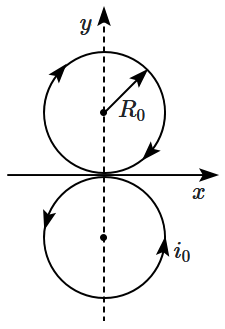Select Question Set:
A circular loop of area \(1\) cm2, carrying a current of \(10\) A, is placed in a magnetic field of \(0.1\) T perpendicular to the plane of the loop. The torque on the loop due to the magnetic field is:
1. zero
2. \(10^{-4}\) N-m
3. \(10^{-2}\) N-m
4. \(1\) N-m
1. zero
2. \(10^{-4}\) N-m
3. \(10^{-2}\) N-m
4. \(1\) N-m
Subtopic: Current Carrying Loop: Force & Torque |
55%
From NCERT
To view explanation, please take trial in the course.
NEET 2025 - Target Batch
Hints
To view explanation, please take trial in the course.
NEET 2025 - Target Batch
A current-carrying straight wire is kept along the axis of a circular loop carrying a current. The straight wire
| 1. | will exert an inward force on the circular loop |
| 2. | will exert an outward force on the circular loop |
| 3. | will not exert any force on the circular loop |
| 4. | will exert a force on the circular loop parallel to itself |
Subtopic: Current Carrying Loop: Force & Torque |
60%
From NCERT
To view explanation, please take trial in the course.
NEET 2025 - Target Batch
Hints
To view explanation, please take trial in the course.
NEET 2025 - Target Batch
A long, straight wire carries a current along the \(z-\)axis. One can find two points in the \(X-Y\) plane such that:
| (a) | the magnetic fields are equal |
| (b) | the direction of the magnetic fields are the same |
| (c) | the magnitude of the magnetic fields are equal |
| (d) | the field at one point is opposite to that at the other point |
Choose the correct option :
| 1. | (a), (b), (c) | 2. | (b), (c), (d) |
| 3. | (c), (d), (a) | 4. | all of the above |
Subtopic: Magnetic Field due to various cases |
From NCERT
To view explanation, please take trial in the course.
NEET 2025 - Target Batch
Hints
To view explanation, please take trial in the course.
NEET 2025 - Target Batch
A current-carrying wireframe is in the shape of digit eight \((8).\) It is carrying current \(i_0.\) If the radius of each loop is \(R_0,\) then the net magnetic dipole moment of the figure is:


| 1. | \(\left({{i}_{0}\mathit{\pi}{R}_{0}^{2}}\right)\sqrt{2} \) | 2. | zero |
| 3. | \({i}_{0}\times{2}\mathit{\pi}{R}_{0}^{2} \) | 4. | \({i}_{0}\left({{4}\mathit{\pi}{R}_{0}}\right) \) |
Subtopic: Magnetic Moment |
89%
From NCERT
Please attempt this question first.
Hints
Please attempt this question first.
The strength of the magnetic field around a straight current-carrying conductor as observed by Biot and Savart was that:
| 1. | field is the same every where around the conductor. |
| 2. | field is directly proportional to the square of the current flowing in the conductor. |
| 3. | field obeys the inverse square law of distance. |
| 4. | magnetic field strength was maximum on the axis of the current conductor. |
Subtopic: Biot-Savart Law |
78%
From NCERT
Please attempt this question first.
Hints
Please attempt this question first.
The figure shows a current carrying loop having four segments \(1,\) \(2,\) \(3\) and \(4.\) The magnitude of the magnetic field at centre \(\mathrm{O}\) is maximum due to:


| 1. | segment \(1\) | 2. | segment \(2\) |
| 3. | segment \(3\) | 4. | segment \(4\) |
Subtopic: Biot-Savart Law |
84%
From NCERT
Please attempt this question first.
Hints
Please attempt this question first.
A straight current-carrying wire carrying current \(I\) passes perpendicular to the plane of an imaginary rectangular loop \(PQRS\), passing through its centre \(O\) (into the diagram). The diagonals intersect at \(60^\circ,\) and side \(PS\) is smaller than side \(PQ\). The value of \(\int \vec{B} \cdot d\vec{l}\) evaluated from \(P\) to \(Q\) (along \(PQ\)) has the magnitude:


| 1. | \(\dfrac{\mu_{0} I}{6}\) | 2. | \(\dfrac{2 \mu_{0} I}{6}\) |
| 3. | \(\dfrac{4\mu_{0} I}{6}\) | 4. | \(\dfrac{5\mu_{0} I}{6}\) |
Subtopic: Ampere Circuital Law |
52%
From NCERT
To view explanation, please take trial in the course.
NEET 2025 - Target Batch
Hints
To view explanation, please take trial in the course.
NEET 2025 - Target Batch
Two long conductors, separated by a distance \(d,\) carry currents \(I_1\) and \(I_2\) in the same direction, exerting a force \(F\) on each other. Now, the current in one of the conductors is doubled and its direction is reversed, while the separation distance between the conductors is increased to \(3d.\) What is the new force between the conductors?
1. \(-2F\)
2. \(F/3\)
3. \(-2F/3\)
4. \(-F/3\)
1. \(-2F\)
2. \(F/3\)
3. \(-2F/3\)
4. \(-F/3\)
Subtopic: Force between Current Carrying Wires |
86%
From NCERT
Please attempt this question first.
Hints
Please attempt this question first.
A proton is rotating along a circular path with kinetic energy \(K\) in a uniform magnetic field \(B.\) If the magnetic field is made four times keeping the radius constant, then what will be the kinetic energy of rotation of the proton?
| 1. | \(16K\) | 2. | \(8K\) |
| 3. | \(4K\) | 4. | \(K\) |
Subtopic: Lorentz Force |
74%
From NCERT
Please attempt this question first.
Hints
Please attempt this question first.
A current \(i\) flows through a semi-circular loop of radius \(r,\) attached to two long straight wires along the open diameter of the loop. The magnetic field at the centre of the loop is:


| 1. | \(\dfrac{\mu_0i}{4r}\) |
| 2. | \(\dfrac{\mu_0i}{4r}+\dfrac{\mu_0i}{2\pi r}\) |
| 3. | \(\dfrac{\mu_0i}{4r}+\dfrac{\mu_0i}{4\pi r}\) |
| 4. | \(\left[\left(\dfrac{\mu_0i}{4r}\right)^2+\left(\dfrac{\mu_0i}{4\pi r}\right)^2\right]^{\frac12} \) |
Subtopic: Magnetic Field due to various cases |
84%
From NCERT
To view explanation, please take trial in the course.
NEET 2025 - Target Batch
Hints
To view explanation, please take trial in the course.
NEET 2025 - Target Batch
Select Question Set:






